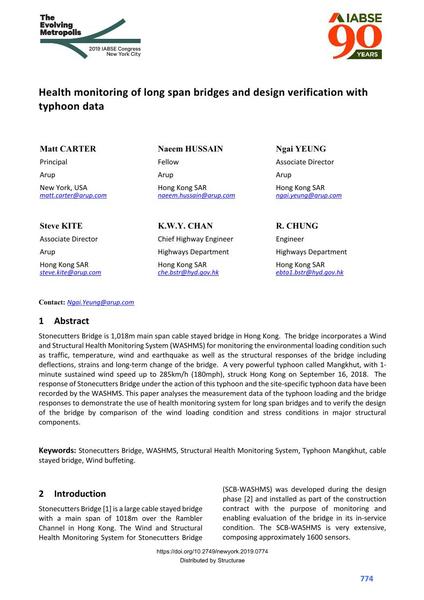Health monitoring of long span bridges and design verification with typhoon data

|
|
|||||||||||
Bibliographic Details
| Author(s): |
Matt Carter
(Arup)
Naeem Hussain (Arup) Ngai Yeung (Arup) Steve Kite (Arup) K. W. Y. Chan (Highways Department) R. Chung (Highways Department) |
||||
|---|---|---|---|---|---|
| Medium: | conference paper | ||||
| Language(s): | English | ||||
| Conference: | IABSE Congress: The Evolving Metropolis, New York, NY, USA, 4-6 September 2019 | ||||
| Published in: | The Evolving Metropolis | ||||
|
|||||
| Page(s): | 774-787 | ||||
| Total no. of pages: | 14 | ||||
| DOI: | 10.2749/newyork.2019.0774 | ||||
| Abstract: |
Stonecutters Bridge is 1,018m main span cable stayed bridge in Hong Kong. The bridge incorporates a Wind and Structural Health Monitoring System (WASHMS) for monitoring the environmental loading condition such as traffic, temperature, wind and earthquake as well as the structural responses of the bridge including deflections, strains and long-term change of the bridge. A very powerful typhoon called Mangkhut, with 1- minute sustained wind speed up to 285km/h (180mph), struck Hong Kong on September 16, 2018. The response of Stonecutters Bridge under the action of this typhoon and the site-specific typhoon data have been recorded by the WASHMS. This paper analyses the measurement data of the typhoon loading and the bridge responses to demonstrate the use of health monitoring system for long span bridges and to verify the design of the bridge by comparison of the wind loading condition and stress conditions in major structural components. |
||||
| Keywords: |
Stonecutters Bridge wind buffeting structural health monitoring system cable stayed bridge WASHMS Typhoon Mangkhut
|
||||
